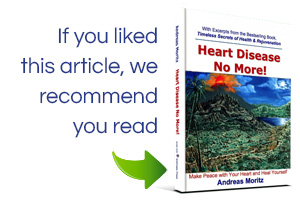By Andreas Moritz
Risk Indications of a Heart Attack
Most food-related blood vessel diseases, including heart attacks, stroke, rheumatism, and angina pectoris, are not primarily disorders of sugar and fat metabolism, but diseases resulting from protein storage. Eating too much protein food can be considered one of the greatest risk factors for developing any kind of disease. The thickening of the basal membranes of blood vessels and connective tissues caused by the storage of protein affects the very lives of all cells in the body. When and wherever in the body such congestion occurs, premature aging of cells and organs result. On the other hand, wherever the capillary walls maintain their porous, flexible nature and original thinness, cell nourishment and organ vitality continue throughout life.
Fat and cholesterol are not the primary blocking agents of blood vessel walls and, can therefore, not be considered to be the main cause of heart disease or any other disease in the body. Storage of protein in the blood vessel walls, on the other hand, is the common factor in all patients who suffer from alimentary (food-caused) atherosclerosis. Since most people in the advanced nations have consistently been consuming excessively large quantities of protein, particularly since World War II, coronary heart disease has become the leading cause of death in the developed world. As you will be able to see below, most of the leadingrisk elements of suffering a heart attack are directly or indirectly linked with high protein consumption and protein deposits in the blood vessel walls. The thickening of blood is an indication of such a risk.
Thickening of blood as measured by Hemocrit or Packed Cell Volume
The Hemocrit is the volume of red blood cells in one liter of whole blood, determined by a simple and cheap blood test. If it is above 42%, the risk of a heart attack increases. A healthy person has a Hemocrit of 35% to 40%. Under the assumption that the presence of larger quantities of protein in the blood is harmless, many doctors consider a volume of 44-50% to be still in the normal range; research, however, has shown that heart attacks were twice as high when the Hemocrit reached 49% compared to when it was 42%. The fact is that the higher the Hemocrit rises the greater is the risk of suffering a heart attack.
The question arises, why would the volume of red blood increase to beyond 40%? When the basal membranes and the intercellular tissues become thickened due to storage of excessive protein, blood flow slows down and becomes obstructed. This ‘naturally’ increases the concentration of all blood values, including proteins, fats, and sugar. The thickening of the blood poses a great risk that affects all parts of the body. To deal with the dangerously high concentration of protein in the blood, the pancreas secretes extra insulin, but in doing so, the insulin may further injure and weaken the blood vessel walls. The cells making up the capillary walls start to absorb some the excessive protein, convert it into collagen, and deposit it in their basal membranes. Although this has a much-needed thinning effect on the blood, it also reduces nutrient transport to the cells. When the cells signal malnutrition, the blood nutrient levels begin to rise until the pressure of diffusion is high enough again to deliver enough nutrients to the cells.
In the meanwhile, this constant maneuvering raises the number of red blood cells, which contain the red colored hemoglobin. Hemoglobin combines with oxygen in the lungs and transports it to all the body cells. With increased thickness of the basal membranes, the oxygen supply to the cells also becomes restricted. The resulting increased need for oxygen by the cells raises hemoglobin concentrations in the red blood cells. However, this makes the red blood cells swell up. Eventually, they are too enlarged to pass through the tiny capillaries, blocking them altogether.
This even more drastically cuts down the nutrient and water supply to the cells, which subsequently begin to suffer dehydration. To signal dehydration, the cells release their water deficiency enzyme renin into the tissue fluid, which through a myriad of chemical events leads to an increase of heartbeat and cardiac output. This emergency measure increases water supply to the cells and prevents their demise, but it also raises the blood pressure. Known as essential hypertension, this situation causes even more stress and damage to the blood vessels than have already occurred. The vicious cycle is closed. The preconditions of suffering a heart attack are now in place.
We can therefore conclude that both factors combined (an increased Hemocrit, which indicates increased blood thickening, and a higher hemoglobin concentration in the red blood cells) reduce blood circulation. A round, red-colored face and chest are typical indications of an abnormally high blood volume and a decreased blood circulation in the adult hypertensive and diabetic patient. The cell tissues begin to dehydrate as water distribution becomes increasingly difficult. The rate and force of contraction of the heart muscle increases to help maintain the cardiac output against a sustained rise in congestion throughout the circulatory system. Eventually, the heart can no longer afford such strenuous activity and collapses.
——————————
This is an excerpt from my book HEART DISEASE NO MORE!
——————————
You may share or republish this article provided you clearly mention the name of Andreas Moritz and paste a hyperlink back to the web page

